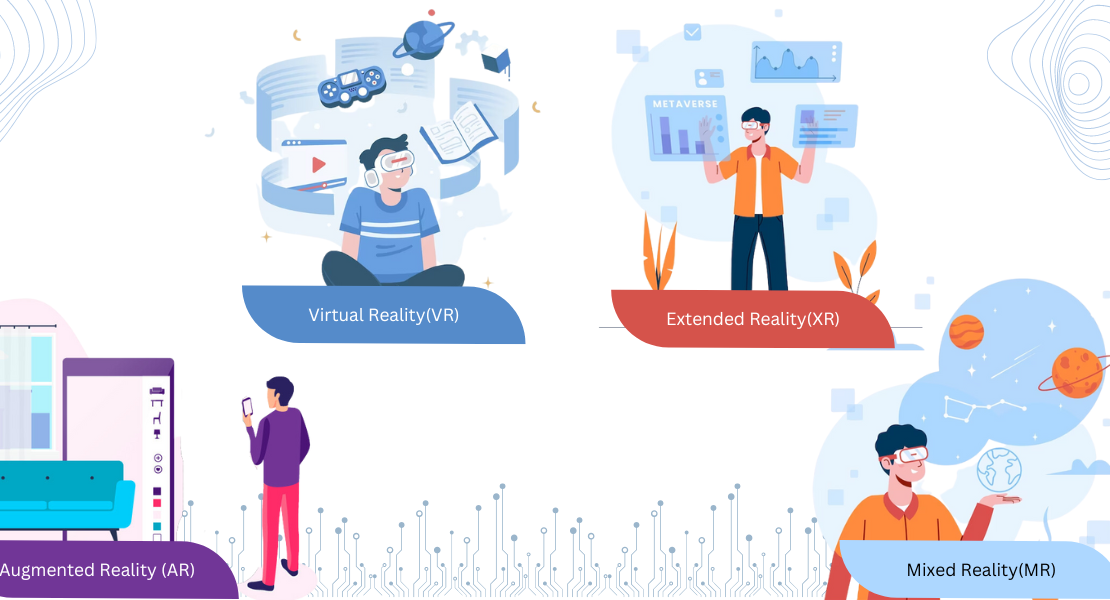
The world of immersive technology can be confusing, with terms like Augmented Reality (AR), Virtual Reality (VR), Mixed Reality (MR), and Extended Reality (XR) often used interchangeably. In this blog post, we will break down the differences between AR, VR, MR, and XR and provide clear examples of each.
What is Augmented Reality (AR)?
Augmented Reality is a technology that overlays digital information, such as text, images, and animations, onto the real world. AR can be experienced through a smartphone, tablet, or a special AR headset. The technology uses the camera on the device to identify objects or markers in the real world and superimpose digital content onto them. The digital content can be interactive and responsive to real-world changes.
An excellent example of AR is the popular mobile game, Pokémon Go. The game uses the camera on your smartphone to project Pokémon characters onto the real world. The characters move around and interact with the environment, creating an immersive and interactive experience.
What is Virtual Reality (VR)?
Virtual Reality is a technology that immerses users in a completely simulated environment. VR uses a headset that blocks out the real world and displays a 360-degree view of a virtual world. The technology tracks the user’s movements and adjusts the virtual environment accordingly, creating a fully immersive experience.
An excellent example of VR is the Oculus Rift, a popular VR headset. The device uses a combination of sensors and motion tracking to create a virtual environment that responds to the user’s movements. Users can explore virtual worlds, play games, and even interact with other users in a virtual space.
What is Mixed Reality (MR)?
Mixed Reality is a technology that combines elements of both AR and VR. MR uses a headset that overlays digital content onto the real world, similar to AR. However, unlike AR, the digital content is anchored to the real world and can interact with it, creating a more immersive experience.
An excellent example of MR is the Microsoft HoloLens. The headset projects holographic images onto the real world, which users can interact with using gestures and voice commands. The holograms are anchored to real-world objects, and users can walk around and interact with them as if they were real.
What is Extended Reality (XR)?
Extended Reality is a term used to describe immersive technologies that combine AR, VR, and MR. XR can refer to any technology that enables users to interact with digital content in a realistic and immersive way, whether it’s through a headset, a smartphone, or other devices. XR is a broad term that encompasses all the immersive technologies mentioned above, and it is often used to describe technologies that blur the line between the real world and the digital world.
An excellent example of XR is the Magic Leap One, a headset that combines AR and MR to create a seamless and immersive experience. The device uses sensors to map the user’s surroundings and overlays digital content onto the real world, allowing users to interact with it as if it were real.
Key Differences between these AR, VR, MR and XR technologies
Augmented Reality (AR): overlays digital information onto the real world, creating an interactive and immersive experience.
Virtual Reality (VR): creates a fully immersive digital environment that simulates reality.
Mixed Reality (MR): combines the real and virtual worlds, allowing for interaction and manipulation of virtual objects in a real-world environment.
Extended Reality (XR): is an umbrella term that encompasses all immersive technologies, including AR, VR, and MR.
Conclusion
While each technology has its own unique features and benefits, the key difference lies in the degree of immersion and the level of interaction with the real world. AR and MR allow for interaction with the real world, while VR creates a fully immersive digital environment. XR provides a versatile platform that can be adapted to various industries and applications.
Augmented Reality, Virtual Reality, Mixed Reality, and Extended Reality are all immersive technologies that offer unique experiences. Understanding the differences between these technologies can help you choose the right one for your needs, whether it’s for gaming, education, or business. As immersive technologies continue to evolve, we can expect to see even more innovations and advancements in the years to come.
Augmented Reality (AR) technology has revolutionized the way products are marketed and sold. With MirrAR, retailers and businesses can now offer customers the ability to virtually try on their products, providing a unique and interactive shopping experience. MirrAR is a virtual try-on platform that utilizes AR technology to allow customers to see how a piece of Jewellery or Watch or clothing or makeup product will look on them before they buy it. The platform is easy to use and can be integrated into a business’s e-commerce website or mobile app. Contact us for more information here using this link MirrAR.
